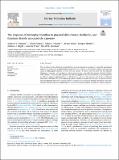Files in this item
The response of microphytobenthos to physical disturbance, herbicide, and titanium dioxide nanoparticles exposure
Item metadata
| dc.contributor.author | Rimmer, James | |
| dc.contributor.author | Hubas, Cédric | |
| dc.contributor.author | Wyness, Adam J. | |
| dc.contributor.author | Jesus, Bruno | |
| dc.contributor.author | Hartley, Morgan | |
| dc.contributor.author | Blight, Andrew J. | |
| dc.contributor.author | Prins, Antoine | |
| dc.contributor.author | Paterson, David | |
| dc.date.accessioned | 2022-11-23T12:30:03Z | |
| dc.date.available | 2022-11-23T12:30:03Z | |
| dc.date.issued | 2022-12-01 | |
| dc.identifier | 282110851 | |
| dc.identifier | 6c677fe5-96c8-4ba0-bb57-82a810b66984 | |
| dc.identifier | 85142335844 | |
| dc.identifier | 000891777200006 | |
| dc.identifier.citation | Rimmer , J , Hubas , C , Wyness , A J , Jesus , B , Hartley , M , Blight , A J , Prins , A & Paterson , D 2022 , ' The response of microphytobenthos to physical disturbance, herbicide, and titanium dioxide nanoparticles exposure ' , Marine Pollution Bulletin , vol. 185 , no. Part B , 1134348 . https://doi.org/10.1016/j.marpolbul.2022.114348 | en |
| dc.identifier.issn | 0025-326X | |
| dc.identifier.other | ORCID: /0000-0003-1174-6476/work/123614298 | |
| dc.identifier.other | ORCID: /0000-0002-9665-8813/work/123614559 | |
| dc.identifier.uri | https://hdl.handle.net/10023/26472 | |
| dc.description | Funding: The research leading to these results received funding from the European Union's Horizon 2020 research and innovation programme under grant agreement No 730984, ASSEMBLE Plus project. AJW was funded by the John Templeton Grant 60501, “Putting the Extended Evolutionary Synthesis to the Test”. DMP and AJB were supported by the NERC Blue-coast award (NE/N016009/1). | en |
| dc.description.abstract | The microphytobenthos that form transient biofilms are important primary producers in intertidal, depositional habitats, yet we have only a limited understanding of how they respond to the cumulative impacts of the growing range of anthropogenic stressors to which they are exposed. We know even less about how the temporal alignment of exposure – such as duration and exposure sequence – may affect the response. Estuarine biofilms were cultured in mesocosms and exposed to the herbicide glyphosate and titanium dioxide (TiO2) nanoparticles in different sequences (glyphosate-first or TiO2-first), as well as in the presence and absence of physical disturbance. We found that at environmentally realistic chemical concentrations, the order of exposure was less important than the total stressor scenario in terms of impacts on key functional attributes and diatom community structure. Physical disturbance did not have an impact on functional attributes, regardless of exposure sequence. | |
| dc.format.extent | 10 | |
| dc.format.extent | 1553804 | |
| dc.language.iso | eng | |
| dc.relation.ispartof | Marine Pollution Bulletin | en |
| dc.subject | Microphytobenthos | en |
| dc.subject | Stressor | en |
| dc.subject | Glyphosate | en |
| dc.subject | Titanium dioxide | en |
| dc.subject | Nanoparticles | en |
| dc.subject | QH301 Biology | en |
| dc.subject | NDAS | en |
| dc.subject | MCC | en |
| dc.subject.lcc | QH301 | en |
| dc.title | The response of microphytobenthos to physical disturbance, herbicide, and titanium dioxide nanoparticles exposure | en |
| dc.type | Journal article | en |
| dc.contributor.sponsor | European Commission | en |
| dc.contributor.sponsor | John Templeton Foundation | en |
| dc.contributor.sponsor | NERC | en |
| dc.contributor.institution | University of St Andrews. School of Biology | en |
| dc.contributor.institution | University of St Andrews. Sediment Ecology Research Group | en |
| dc.contributor.institution | University of St Andrews. Scottish Oceans Institute | en |
| dc.contributor.institution | University of St Andrews. Coastal Resources Management Group | en |
| dc.contributor.institution | University of St Andrews. Marine Alliance for Science & Technology Scotland | en |
| dc.contributor.institution | University of St Andrews. St Andrews Sustainability Institute | en |
| dc.identifier.doi | https://doi.org/10.1016/j.marpolbul.2022.114348 | |
| dc.description.status | Peer reviewed | en |
| dc.identifier.grantnumber | 730984 | en |
| dc.identifier.grantnumber | 60501 | en |
| dc.identifier.grantnumber | NE/N016009/1 | en |
This item appears in the following Collection(s)
Items in the St Andrews Research Repository are protected by copyright, with all rights reserved, unless otherwise indicated.

